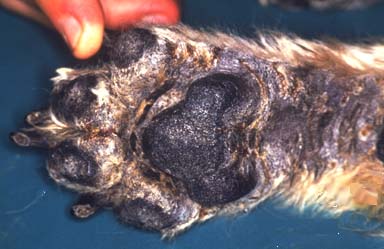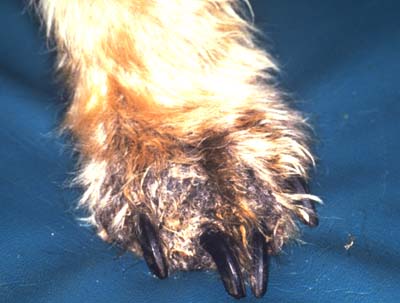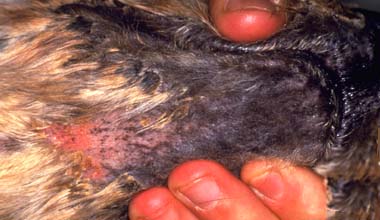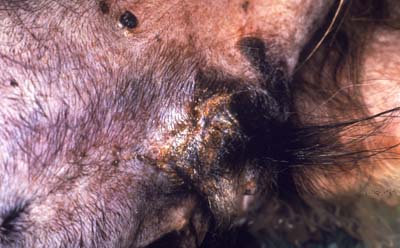Hepatocutaneous syndrome
Synonym(s): Superficial necrolytic dermatitis, necrolytic migratory erythema, glucagonoma syndrome, diabetic dermatopathy, ulcerative dermatosis
Introduction
- Very rare condition in dogs.
- Cause: in humans is a paraneoplastic dermatosis usually associated with glucagonomas, in dogs associated with several hepatopathies, diabetes, Cushing's syndrome.
- Signs: dermatological signs at typical sites (feet, muzzle, axilla, inguinal, anogenital area); signs of underlying hepatic pathology, diabetes mellitus.
- Diagnosis: signs, laboratory tests of hepatic function, skin histopathology.
- Treatment: management of underlying disease, symptomatic care.
- Prognosis: poor.
Presenting signs
- Ulcerative and often suppurative dermatological changes affecting typical site (feet

 , muzzle
, muzzle  , axilla, groin, anogenital area
, axilla, groin, anogenital area  ).
). - Hyperkeratosis and crusting of footpads.
- Crusting on tip of ears.
- Polyuria/polydipsia.
- Weight loss.
- Anorexia.
- Lethargy.
Age predisposition
- Middle aged to older.
Breed/Species predisposition
- Shetland Sheepdog Shetland Sheepdog.
Cost considerations
- Diabetes mellitus.
Pathogenesis
Etiology
- Underlying hepatopathy:
- Cirrhosis Liver: cirrhosis.
- Chronic hepatitis Liver: chronic disease - overview Liver: chronic hepatitis.
- Diabetes mellitus Diabetes mellitus.
- Pancreatic neoplasia Pancreas: neoplasia.
- Chronic pancreatitis Pancreatitis: acute.
- Glucagonoma Pancreas: neoplasia (rare in dogs).
Pathophysiology
- In humans commonly associated with glucagonoma and removal of tumor results in resolution of lesion.
- Rare reports of glucagonoma association in dogs.
- Metabolic disorder of epidermis.
- Proposed pathogenesis: a metabolic defect (elevated glucagon, amino acid deficiency and/or zinc deficiency) responsible for epidermal necrosis.
- Increased glucagon levels→ increased gluconeogenesis and then amino acid utilization → cell starvation and necrosis. The sustained gluconeogenesis associated with hyperglucagonemia results in excessive protein and amino acid utilization (especially niacin and tryptophan which is required for glucagon synthesis). Hypoaminoacidemia (found in 97% of human cases of NME) is thought to result in epidermal depletion and consequent cutaneous necrosis.
- Mechanism of development of condition is poorly understood. Several suggestions:
- In clinical cases there is increased [arachidonic acid] in epidermis which may be the result of increased [glucagon].
- Local inflammation may → release of inflammatory mediators?
- Skin lesions may arise as a result of decreased [amino acids] and [zinc] in plasma and skin: malabsorption/maldigestion as a result of abnormal hepatic/pancreatic function.
- Sequestering of tryptophan into glucagonomas.
Timecourse
- Weeks to months.
Diagnosis
Subscribe To View
This article is available to subscribers.
Try a free trial today or contact us for more information.
Treatment
Subscribe To View
This article is available to subscribers.
Try a free trial today or contact us for more information.
Prevention
Subscribe To View
This article is available to subscribers.
Try a free trial today or contact us for more information.
Outcomes
Subscribe To View
This article is available to subscribers.
Try a free trial today or contact us for more information.
Further Reading
Publications
Refereed papers
- Recent references from PubMed and VetMedResource.
- Hill P B, Auxilia S T, Munro E, Genovese L, Silkstone M A & Kirby B (2000) Resolution of skin lesions and long-term survival in a dog with superficial necrolytic dermatitis and liver cirrhosis. JSAP 41 (11), 519-523 PubMed.
- Torres S M, Caywood D D, O'Brien T D et al (1997) Resolution of superficial necrolytic dermatitis following excision of a glucagon-secreting pancreatic neoplasm in a dog. JAAHA 33 (4), 313-319 PubMed.
- Kuhl K A (1996) Newly reported skin diseases. Vet Med 91 (11), 1007-1020 VetMedResource.
- Yoshida M, Barata K, Ando-Lu J et al (1996) A case report of superficial necrolytic dermatitis in a beagle dog with diabetes mellitus. Toxicol Pathol 24 (4), 498-501 PubMed.
- Kasper C S & McMurry K (1991) Necrolytic migratory erythema without glucagonoma versus canine superficial necrolytic dermatitis - is hepatic impairment a clue to pathogenesis? J Am Acad Dermatol 25 (3), 534-541 PubMed.
- Gross T L, O'Brien T D, Davies A P & Long R E (1990) Glucagon-producing pancreatic endocrine tumors in two dogs with superficial necrolytic dermatitis. JAVMA 197 (12), 1619-1622 PubMed.
Other sources of information
- Torres S, Johnson K, McKeever P et al (1997) Superficial necrolytic dermatits and a pancreatic endocrine tumor in a dog. JSAP 38, 246-250.
- Miller W H, Scott D W, Bueger R G, Shanley K J, Paradis M et al (1990) Necrolytic migratory erythema in dogs; a hepatocutaneous syndrome. JAAHA 26, 573-581.
- Walton D J, Center S A, Scott D W & Collins K (1985) Ulcerative dermatosis associated with diabetes mellitus in the dog; a report of 4 cases. JAAHA 22, 79-88.